The heart of eMaint X3 is work order management. Work orders are the vehicles for recording the activities you perform, the physical documents you provide the people performing the work, and the tracking device for all related activities. The Work Order tab is the central location for all work performed in eMaint.
This document briefly discusses the process of locating, adding, editing and closing work orders.
The List View
Clicking the Work Order tab displays all the work order listings, enabling you to view the complete list of work orders in your system.
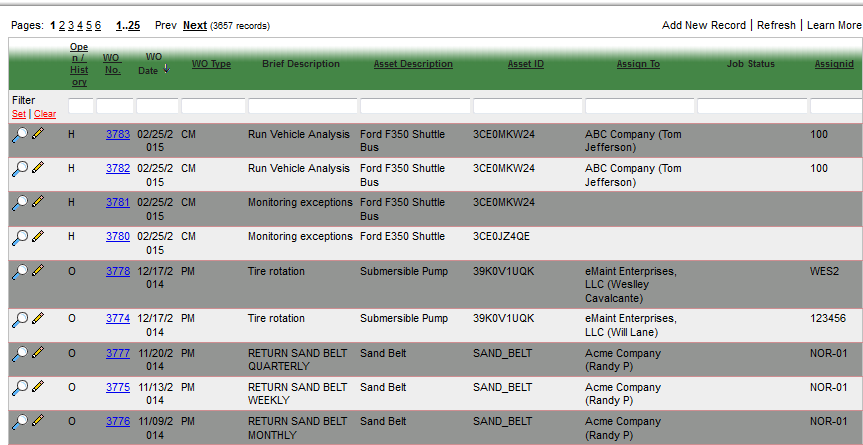
Each work order displayed in the list has its "WO No." underlined. This means you can click the work order number to see the record in detail. To the left of each row are a magnifying glass icon and a pencil icon. You can click the magnifying glass icon to see the detail record of the work order. You can click the pencil icon to edit the work order record.
From this screen you can add a new work order to the list by clicking Add New Record in the upper right corner. If any changes were made to a work order while this window was open, click Refresh to reload the page. The Learn More link provides a brief description of the list view and how to navigate around it. To close the window and return to the main menu, click the Close Window link in the upper right corner.
Click the Form Options link at the bottom of the list to change the default settings of how this screen is displayed. This feature is described in more detail in the System Administration training manual.
Searching your Work Orders
You can expand your search further by applying sorts and/or filters.
Sorting the list
Click on one of the column headings and the list will sort in ascending order. Once sorted, a small arrow icon (pointing up) will appear to the right of the column name. This indicates that the list is sorted in ascending order. Click the arrow icon and the list will sort again, this time in descending order.
Applying Filters to the List
Filters are used to search the whole list and display the matching results. For example, if you wanted to see only those work orders whose WO Type begins with the letter P , you would type the letter P in the filter for the WO Type column and then click the red Set link to the left of the filter row. Besides displaying the results, the number of records that matched the filter expression will display in the upper left of the screen. You can apply single or multiple filters at one time if needed.
To remove the filters, click the red Clear link. The full list will display.
TIP: The system remembers the filters and sorts that you apply and will display it the next time you navigate to that list.
Detail View
Clicking on the WO No. or on the magnifying glass on the work order list view will open the detail view of a work order (see below).
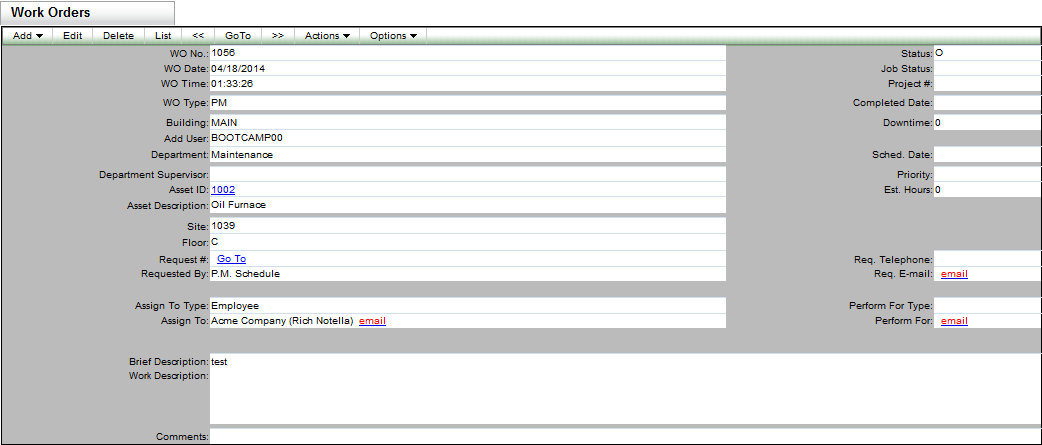
NOTE: With eMaint X3, you have the ability to add or remove fields to the screen as well as change field names and attributes, screen layout, colors, etc. Your screen may look slightly different than the example above. This functionality is explained in detail in the System Administration training manual.
The detail view contains all of the information of a work order. From this screen, you have total control of your work orders.
Options at the top left corner of the screen include:
Add - Opens a blank record for entering a new work order. Copy/Add - Opens a new record in Add mode and populates the form with the previous record's values. Edit - Opens the record in Edit mode for changing the work order's information. Delete - Marks the record for deletion and removes it from the list view. List - Returns to the list view. Previous - Displays the detail of the previous record (ordered by ID). Next - Displays the detail of the next record (ordered by ID). GoTo - Opens a window that allows you to navigate directly to a record by entering the WO No. Close Out - Opens the Close Out screen to mark the work order as completed. Print - Opens the Print Work Order screen for selecting the print form. Purchase - Opens a new Purchase Order form for ordering parts related to the work order. Signature Signoff - Allows the user the create a signature for the work order.
Adding Work Orders
You can add new work orders from either the list or detail view. From the list view, the Add New Record link is directly above the field headers and will open a new window in add mode. From the detail view, the Add choice is the first in the main menu bar and will change the current window to add mode. The Copy/Add option also changes the current window to add mode, except it will populate the form with the previous record's values for fast record entry.
The system will also create new work orders to reflect other features throughout the system. One example of this is automatically generated PMs.
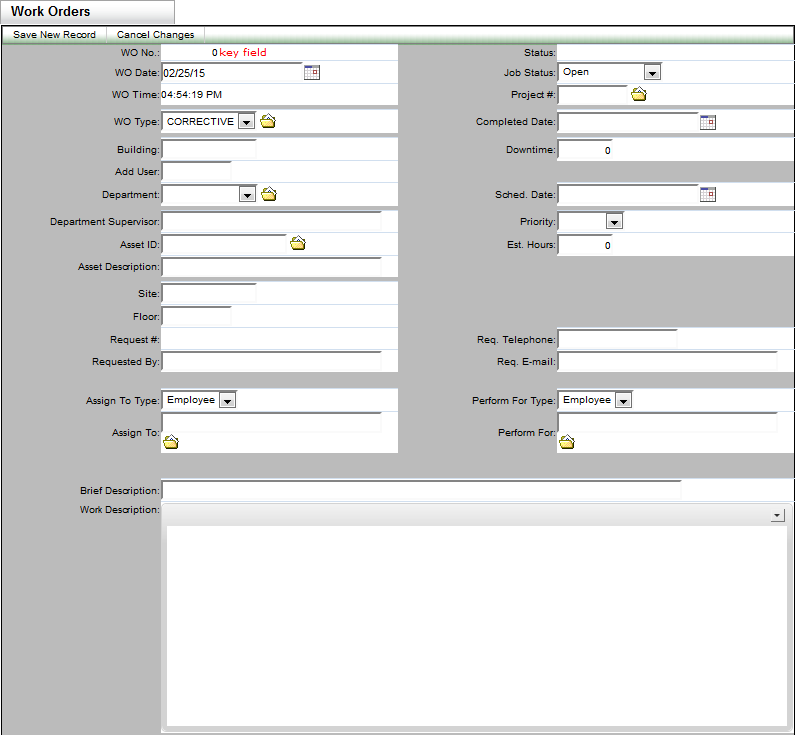
The main fields to populate are the Asset ID, Assign To, Brief Description and Detailed Description. It is always best to insert as much information about the work as possible to remove any guess work from your employees and contractors.
Be sure your maintenance contacts have valid email addresses or the various email features of the work order will not function.
Editing Work Orders
The form for editing work order information can also be accessed from either the list or detail views. From the list, click the pencil icon. From the detail view, click the Edit link in the menu bar. Both links will open the edit form in the existing window. Click Save Changes to save the changes or Cancel Changes to discard them. The form will return to the detail view of the work order.
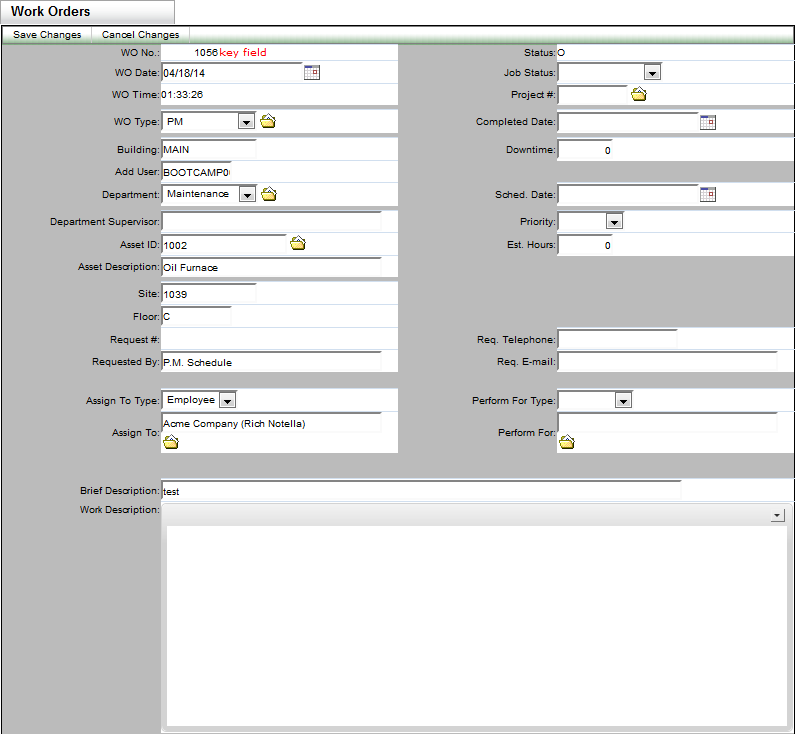
Editing In Place
If Edit In Place is enabled, you can make changes to most fields without the need for entering edit mode. Enter the record's detail screen by clicking on the Magnifying Glass icon or the WO No. link on the list view. Place your mouse  cursor over the field you wish to edit. If the field is able to be edited, the cursor will change to a pencil
cursor over the field you wish to edit. If the field is able to be edited, the cursor will change to a pencil  . Double-click your left mouse button and the field will open in edit mode. Make your changes then click the save
. Double-click your left mouse button and the field will open in edit mode. Make your changes then click the save  icon to save your changes or click the cancel icon
icon to save your changes or click the cancel icon  to return without saving.
to return without saving.
If a field cannot be edited with Edit In Place, the cursor will change to a no symbol  . These fields require you to enter Edit mode to make any adjustments.
. These fields require you to enter Edit mode to make any adjustments.
Deleting Work Orders
Deleting records is a two step process. The first step is to mark the record for deletion by clicking the Delete link. This removes the record from the list view but still allows you to locate it by using the GoTo link (if you know the record ID) or using the Next and Previous links to page through the records. At this point, you can still un-delete the record by clicking the Un-delete link.

The second step of the deletion process is to completely remove records from system. Go to the Removed Deleted Records link located in the Administration menu. This list displays the various tables that can hold record marked for deletion. Click the magnifying glass icon to preview items that will be deleted. Click the trash can icon to remove all the records for that section.
NOTE: The Remove Deleted Items option permanently removes records. There is no way to bring them back. Use this feature at your own risk.
Close Out
When a work order has been completed, use the Close Out link to close it in the system.
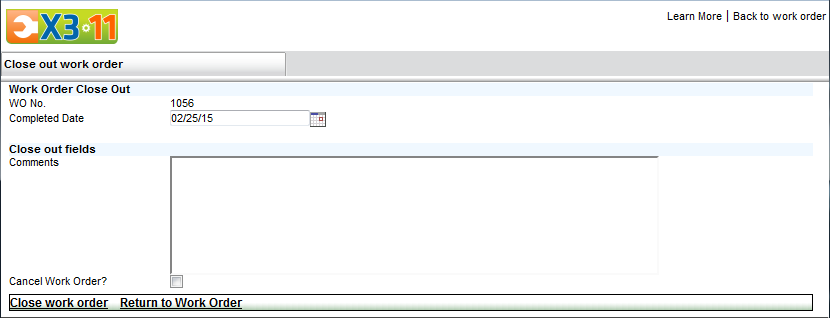
The standard close out screen has two sections: Work Order Close Out and Close out fields.
Work Order Close Out
This section allows you to change the close out date which will be recorded by the system. By default, the WO Completion Date is automatically filled in with today's date.
Close Out Fields
The fields in this section are determined by the system administrator. Any fields which will provide more information about the closing of the work for this job can be added. (System Administration training explains how to select the fields for this close out screen.)
Once you click the Close work order link, the work order is now closed. The Status field is changed from an O (open) to an H (history/closed). Non-PM work orders can be reopened by clicking the Close Out link again and then selecting the reopen link at the bottom of the screen. Reopening the work order will also enable editing of the close out information.
The close out information that was entered can also be viewed (without running a report) by clicking the Close Ou t link from the work order detail.
Print
Use this link to print work orders..
Purchase
The Purchase link opens a new window with a blank purchase order form. This allows you to place orders for parts that are required for the work order.
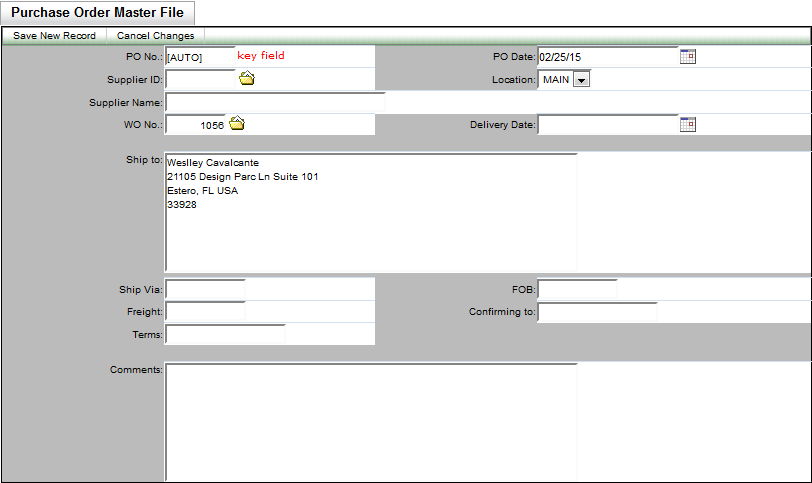
This form is identical to the purchase order form from the Create Purchase Order menu option. Parts on order will be listed on the Purchase table of the work order detail. When the PO is received, the part will be added to the Charges table.
Work Order Charges
The Work Order Charges table lists the various charges made against the work order. Possible charge types are Labor, Parts, Misc and Quick Parts.

To add a charge, use the drop-down list to select the charge type and click the Add Charges button. The window will load the appropriate screen for entering the charge.
Work Procedures
Similar to the PM schedules Procedures table, the Work Procedures table allows you to link a PM Task to the work order. This table will also list the PM Procedures from a generated PM.
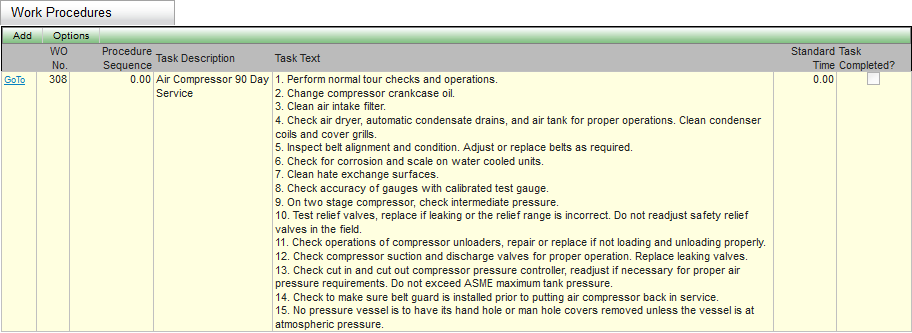
To add a Work Procedure, click the Add link on the right side of the Work Procedure table,
The fields to enter are:
- If there is more than one procedure, enter this procedure's number sequence here.
- Use the file lookup on Task Description to open the PM Task list. Choose a task by clicking the Select link on the left of the task. Task Description and Task Details will automatically populate with the PM Tasks information.
- You can link to a local file, web address or email by entering the value in Web Link . The File button will open the window to help you choose a file on your machine or local network.
- Enter the time the procedure should take in the Standard Time field.
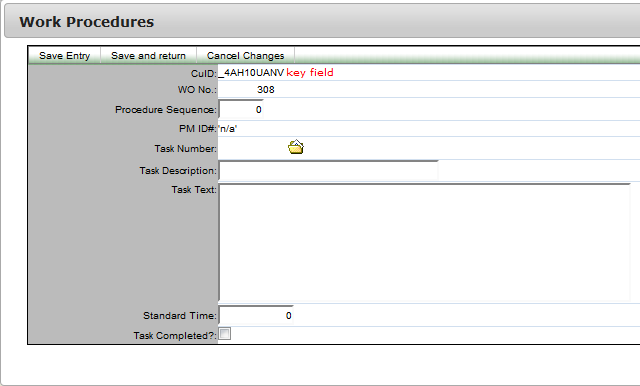
Click Save Entry or Save and return to save the procedure to the work order, or click Cancel Changes to return to the Work Order without saving.
Assignments
The Assignments table works in conjunction with the Scheduling module. Assignments that are attached to a work order will show up under WO Assignments in the scheduler to help your employees track what their work schedule for the day will be.